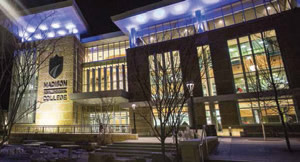Better Lighting for Better Project Flexibility

Madison College enjoyed several benefits when using Lutron lighting for a lighting upgrade. Lutron products helped offer the college design and installation flexibility and required no additional wiring or setup.
For many colleges and universities, the Lutron Vive wireless lighting control solution offers clear advantages for energy saving, labor-reducing lighting retrofits. Because colleges often encompass multiple buildings and campuses, they have a diverse set of lighting control requirements. Recently, Lutron Vive solutions were installed at Wisconsin’s Madison College to help save energy, improve lighting performance and enhance the learning environment.
The college is in the midst of an ongoing lighting upgrade in several buildings to reduce energy costs, meet codes and enhance the flexibility and versatility of the lighting system. Stand-alone controls, installed in many campus spaces, have delivered reliable, efficient performance, but looking forward, the Vive wireless scalable control system is reducing installation times and increasing lighting options in basic classrooms, technology labs, lecture halls, private offices, a culinary building and conference spaces. Using Vive wireless also makes design quick and simple, accommodates changes easily, and helps keep the lighting retrofit within budget.
The Vive system is simple to understand, easy to design, easy to change and easy to manage remotely with the Vive software, creating an opportunity for the control system to have significant impact on electricity and maintenance costs. The Vive control software is another plus, making system changes quick and easy, with no additional wiring required, and no complex set up. All programming can be accomplished on any smart device with the Vive app.
Using Vive wireless systems, Lutron customers like Madison College can realize tremendous design and installation flexibility on their projects. Scalability is often critical to achieving operational goals, which include balancing budgets while still delivering high-quality, reliable lighting control that works for today’s energy and code requirements, and will work for tomorrow’s too. Reducing energy use is good for the environment, the students and any project’s long-term success.
www.lutron.com/vive
This article originally appeared in the issue of .